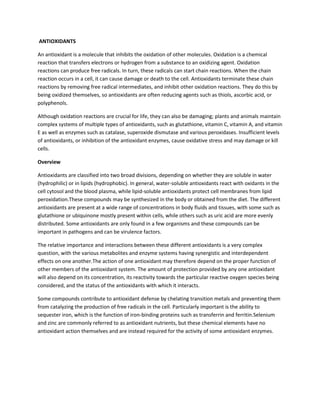
Antioxidant
- 1. ANTIOXIDANTS An antioxidant is a molecule that inhibits the oxidation of other molecules. Oxidation is a chemical reaction that transfers electrons or hydrogen from a substance to an oxidizing agent. Oxidation reactions can produce free radicals. In turn, these radicals can start chain reactions. When the chain reaction occurs in a cell, it can cause damage or death to the cell. Antioxidants terminate these chain reactions by removing free radical intermediates, and inhibit other oxidation reactions. They do this by being oxidized themselves, so antioxidants are often reducing agents such as thiols, ascorbic acid, or polyphenols. Although oxidation reactions are crucial for life, they can also be damaging; plants and animals maintain complex systems of multiple types of antioxidants, such as glutathione, vitamin C, vitamin A, and vitamin E as well as enzymes such as catalase, superoxide dismutase and various peroxidases. Insufficient levels of antioxidants, or inhibition of the antioxidant enzymes, cause oxidative stress and may damage or kill cells. Overview Antioxidants are classified into two broad divisions, depending on whether they are soluble in water (hydrophilic) or in lipids (hydrophobic). In general, water-soluble antioxidants react with oxidants in the cell cytosol and the blood plasma, while lipid-soluble antioxidants protect cell membranes from lipid peroxidation.These compounds may be synthesized in the body or obtained from the diet. The different antioxidants are present at a wide range of concentrations in body fluids and tissues, with some such as glutathione or ubiquinone mostly present within cells, while others such as uric acid are more evenly distributed. Some antioxidants are only found in a few organisms and these compounds can be important in pathogens and can be virulence factors. The relative importance and interactions between these different antioxidants is a very complex question, with the various metabolites and enzyme systems having synergistic and interdependent effects on one another.The action of one antioxidant may therefore depend on the proper function of other members of the antioxidant system. The amount of protection provided by any one antioxidant will also depend on its concentration, its reactivity towards the particular reactive oxygen species being considered, and the status of the antioxidants with which it interacts. Some compounds contribute to antioxidant defense by chelating transition metals and preventing them from catalyzing the production of free radicals in the cell. Particularly important is the ability to sequester iron, which is the function of iron-binding proteins such as transferrin and ferritin.Selenium and zinc are commonly referred to as antioxidant nutrients, but these chemical elements have no antioxidant action themselves and are instead required for the activity of some antioxidant enzymes.
- 2. OXYGEN FREE RADICALS The food we eat and the oxygen we breathe are carried to all parts of the body by the blood. These then enter every cell. Here they go through complex chemical reactions called the Krebs cycle. In the end, this releases water and energy. Sugar + oxygen → Energy + water + CO2 However, oxygen is a very dangerous element. In the body, it reacts with many other biochemicals to form reactive oxygen species (ROS). These include hydrogen peroxide (H2O2), hypochlorous acid (HOCl), hydroxyl radicals (oOH) and superoxide ions (O2-). These ROS can break up proteins and DNA, causing genetic mutations and enzyme failure. In the end this leads to rashes, ulcers and inflammation, which can make you quite sick. The body's own antioxidants To deal with these ROS, our body has many antioxidants of its own. These chemicals attack the dangerous oxygen species and convert them to safer chemicals like water and carbon dioxide. Some of these antioxidants include superoxide dismutase, catalase and glutathione. However, when we eat foods rich in carbohydrates and fats, they produce a lot of ROS in the body. Then its own antioxidants are not enough for the task. We need to get more antioxidants through our food. That's why we need vegetables and fruits. Foods rich in anti-oxidants There are many chemicals found in plants that act as good ROS fighters. These include β-carotene (Vitamin A), ascorbic acid (Vitamin C), tocopherol (Vitamin E) and the element selenium. Vegetables like carrots, pumpkins, tomatoes and spinach are rich in β-carotene, while citrus fruits (oranges and mangoes) are rich in vitamin C. Grains and vegetable oils are quite rich in vitamin E, while fish are good for selenium.